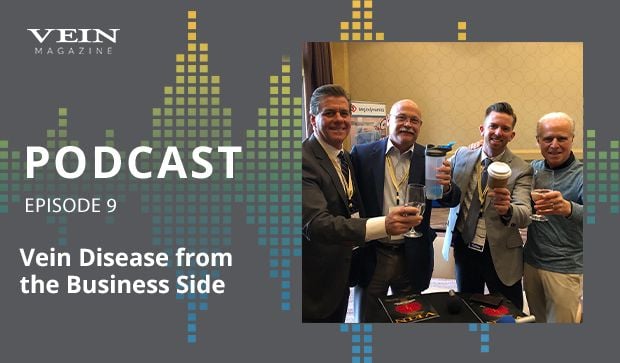
Welcome to the VEIN Magazine podcast with Dr. Steve Elias, where vein specialists sit around, having drinks and talking.
Scott Centea, Sr. Director of Global Marketing, Peripheral Vascular at AngioDynamics; Brian Dempsey, Peripheral Account Manager at Philips Healthcare; and Eric Heil, Vice President of US Commerical at BTG International, join Steve at the 2019 American Venous Forum's annual meeting to discuss the industry’s role in education, appropriate treatment, and the development of new products.
Episode Summary
Harkening back to the first VEIN podcast, this episode seeks to gain a wider perspective on the vein world—not from physicians, like before, but from vein specialists who work to improve patient care through product innovation.
In their discussion, the group poignantly points out difficulties with getting products covered by government-sponsored health care programs like Medicare and reflect on the roadblocks they and others face just trying to get devices to market.
Brian’s company, Philips Healthcare, joined forces with major venous societies and competitors to petition for reimbursement coding for a catheter-based technology that allows physicians to see blood vessels from the inside out (IVUS).
Reimbursement, he noted, is a top consideration every innovator must take into account before even pushing products. Physicians, it is added, are more apt to use devices that have a return.
BTG International traveled a lonely, less-traversed road initially with their non-thermal, non-tumescent injectable foam, Varithena. Because they were the second to enter this particular market—at that time, at least—early on in their commercial launch, they operated independently.
“From our perspective, it was really on us to educate the payers and to ensure that when the product was on the market and claims started coming through, they would be familiar enough with it,” said Eric, noting that the process took longer than expected.
As they made traction with product recognition, three industry partners and six societies worked together for 3 to 4 months to develop a specific position statement they could submit to processing companies for approval.
This behind-the-scenes collaboration was critical to making Varithena more accessible to patients and their providers. The experience, well, it drove BTG to look more at venous society’s role in advocating for products that improve patient quality of life.
Angiodynamics, who acquired a thermal product used to ablate perforator veins, had no trouble getting coverage. Instead, there was a problem with how it was being marketed and sold. Scott and his team had to go back to the drawing board to specify product use. They also put together a controlled trial that would prove the product’s safety and effectiveness.
Once repackaged, they worked with commercial payers and local coverage determinations (LCDs) to understand what’s covered and what’s not. Some tweaks, some years and lots of money later, they got the green light.
Not everyone does, according to Eric. They are all operating in a lengthy time window and shelling out cash, all while trying to innovate in a flooded market with an uncertain adoption rate.
It’s not uncommon for competitors to cut their losses and stop moving products further.
“You have to fight tooth and nail,” Brian agreed.
Thank you for joining us. Subscribe to the VEIN Magazine podcast on iTunes, Apple Podcast, or wherever you listen to podcasts.


